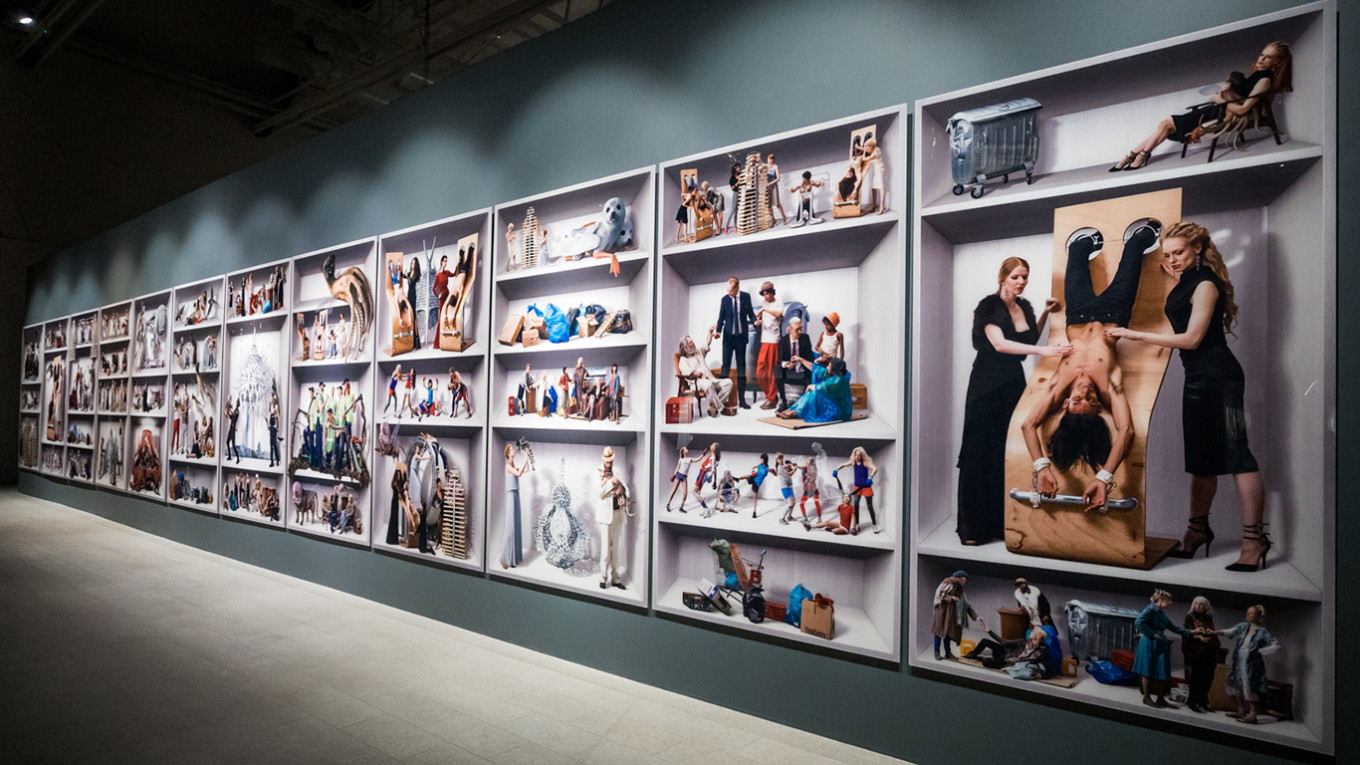
In late July, the internationally acclaimed art group AES + F launched a new exhibition, “Predictions and Revelations,” featuring eight of their biggest projects from the last two decades.
The eye needs time to adjust before it can take in the enormous digital collage installation that greets the visitor to the exhibition “Predictions and Revelations” at the Manege exhibition space. As beautiful models and mythological figures blend into a background of paradisiacal nature, the eye is confused and begins to question the very nature of the image. That is the main feature of the work of AES+F: a blend of photography, allegorical art and digital technology that is instantly appealing and yet mesmerizing.
Founded in Moscow in 1987, the collective was initially established by conceptual architects Tatiana Arzamasova and Lev Yevzovich along with graphic designer Yevgeny Svyatsky and named after the initials of their last names. The trio was later joined in 1995 by the photographer, Vladimir Fridkes, and resulted consequently renamed AES+F.
The Moscow collective first received international recognition in 2007 with the presentation of their video installation “The Last Riot,” which was shown at the Russian pavilion at the Venice Biennale. In the last ten years, the work of the artists has been featured in numerous galleries of contemporary art all over the world — including in Adelaide, Gwangju, Havana, Helsinki, Istanbul, Kiev, Kochi-Muziris, Lille, Lyon, London, Melbourne, Taipei and Vancouver.
In 2011, the four artists were awarded the Sergei Kuryokhin Contemporary Art Award for their video installation “Allegoria Sacra,” which contains references to the painting of the same name by Giovanni Bellini.
Their work includes performances, installations, paintings and illustrations and has been recently incorporating photography, video and digital technologies. But in spite of their modern and sophisticated techniques, the projects are deeply rooted in historical and cultural traditions and make ample use of symbolism, mysticism and other common artistic techniques. AES+F’s art is ultimately aimed at exploring the values, vices and conflicts of contemporary culture and representing them in a multimedia format.
The exhibition at Manege is their largest exhibition, featuring eight of their projects and more than 70 artworks.
On the first floor, visitors find the grand trilogy composed by a trio of large-scale, multichannel video installations and a gallery of digital collages. The trilogy, comprised of “The Last Riot” (2007), “The Feast of Trimalchio” (2009) and “Allegoria Sacra” (2011) are screened in three separate dark rooms where viewers can use headphones.
“The Last Riot,” a virtual world generated by the real world, takes up most of the first floor with pictures, tondos, sculptures and an HD video installation. Young warriors of angelic beauty fight a war without a clear aggressor or victim, in a conflict that metaphorically celebrates the end of ideology, history and ethics.
The second floor features a series of golden statues, parts of the “Action Half-Life” project depicting a series of futuristic-looking young warriors, and “Angels-Demons,” sculptures of the black figures of babies with dragon wings and tails. In addition to the two collections of sculpture, the second floor also hosts the oldest project by the artists presented at this exhibition, the “Islamic Project.” The project, which was produced over seven years, from 1996 to 2003, has often been referred to as prophetic. It is a kind of social psychoanalysis in which the fears of Western societies about Islam are visualized. A colorful Bedouin tent is placed in the middle of the hall and decorated with traditional carpets and Islamic images printed on silk. Visitors are invited to enter and meditate among the red cushions and accompanied by Arabic music.
A separate part of the exhibition is devoted to the project “Turandot,” a new interpretation of the three-act opera by Giacomo Puccini which was premiered in January of this year at the Massimo Theater in Palermo. “Turandot” takes place in a futuristic metropolis in 2070 where the Princess Turandot rules the global empire from Beijing in a techno-feminist matriarchy.
The exhibition, which will run until Sept. 22, offers daily tours with advance registration. A complete visit to the exhibition including the screening of all the video installations takes about four hours.
1 Isaakiyevskaya Ploshchad. Metro Admiralteiskaya. For more information, see the Manege site.

Leave a Reply